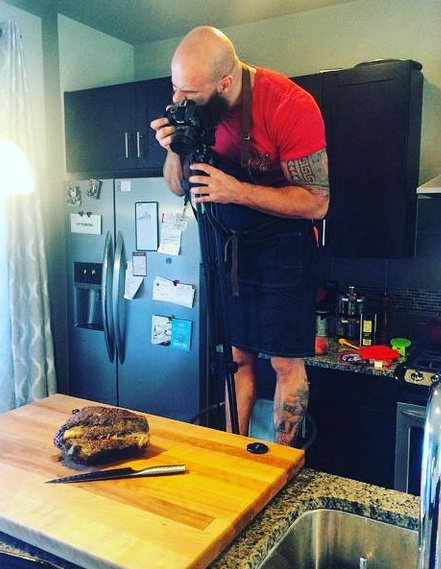
Most folks who have competed as a strength athlete or a bodybuilder know a thing or two about nutrition. Like most of you out there, I have tried just about every diet there is to see what works best for me. Bodybuilding, I must say is more simple, as strength is not an issue, only looking good onstage (just to point out I am not saying bodybuilding is easier before anyone has a hissy fit). As strength athletes we have to diet down, losing sometimes as much as 30lbs while maintaining strength, or hopefully still getting stronger as the competition approaches. Likewise, strength athletes and bodybuilders know how to put some serious weight on quickly. A few times out of the year when I switch back and forth between strongman and powerlifting I will make weight for a contest at 231 and then a few months later come in for a powerlifting meet at 260lbs. Here are some very basic rules you can go by to either get leaner, maintain, and everyone’s favorite: get HYOOOOGE!
I don’t care what anyone says, number one is calories matter. If you are taking in more calories in a day then you are burning you will gain weight. If you burn more calories in a day then you consume you will lose weight. If you are curious about where you are then use a calorie counter to track everything. I know it’s a pain to do but at least in the beginning it will keep you on track for hitting your goals. One thing I have noticed over the years doing nutrition is athletes always over estimate how many calories they take in, and the average person ALWAYS under estimates how much they take in. Sorry, your favorite sports athlete is not eating over 9000 calories a day. At my most I was reaching 6000 calories a day and I was nearly sick at every meal. If you want to put some serious weight, on you should be nearly puking after every meal from being so full. As far as calories go, a general rule to follow is if you want to lose weight then multiply your body weight by 10-13. For example if you weight 200lbs, start by multiplying by 13 for a calorie intake of 2,600 per day. Always start on the lower end, it is best to drop weight slowly as not to sacrifice muscle. To maintain, simply multiply your body weight by 14-16, begin by multiplying by 15 and adjust from there. To gain, start by multiplying by 16 and progressively increase when you start to plateau, again this should be a slow process as not to gain too much body fat.
As a strength athlete, protein is your most important macro nutrient. Most nutrition text books will tell you to get .8 grams per kilogram of bodyweight, but any meathead that has put on a substantial amount of muscle knows otherwise. Aim for at least 1 gram per pound and if you are trying to gain muscle, then make sure you have even more up to the 1.5 gram per pound range. If you are cutting, make sure to still keep your protein intake high at 1 gram per pound as well. Protein should be the last macro to lower as to not lose muscle. I don’t generally count my macros but I do aim for 40-60 grams of protein at each meal. This is a simple rule for any guy to follow to make sure you are getting enough protein. For women shoot for 20-40 grams of protein each meal. Your protein sources should come from quality meat such as chicken, bison, salmon, whole eggs, etc. A good protein powder is an absolute must, and LBEB has the perfect blend for you with True Nutrition you can pick up here.
Carbohydrates are next in line of importance. Carbohydrates are you body’s preferred source of energy! I don’t care what the “keto” guy tells you about how you can burn more fat and be just as strong on no carbs because it is flat out not true. Carbs should be surrounding your workout before, during, and after training. Slow digesting carbs should be your meal within an hour or two before your training. My preferred meal is a lean protein source such as chicken or bison, with jasmine rice, or a sweet potato. If you are in a rush, simply take the LBEB protein, oat starch, and for a great pre workout check out the coffee blend from Kimera (use code LBEB for a discount). One of the biggest mistakes I see is people not eating enough before they train. It’s always better to have real food, but this is where supplements are helpful. For intra workout carbs I have written a previous article here. A simple guide to follow is to have 2 grams of carbs per pound of bodyweight on your heavy days. This would normally be your squat, deadlift, and for strong(wo)man event days. Light to moderate days which would mainly be upper body/accessory days will be from 1 gram to 1.5 grams per pound. I like to carb cycle even when bulking, as to gain less body fat so I will drop my carbs to .5 grams per pound and if I’m cutting I will have no carbs at all.
Fats are an absolute necessity in any diet. Too many times, I have heard people avoiding all fats, even healthy ones, in fear of gaining body fat. The essential fats that cannot be made from carbs and protein are essential for survival, and play a huge role with hormones. Testosterone levels can potentially drop if fat is dropped too low for too long. If you goal is weight loss or gaining muscle, you need all the testosterone you can get. If you are looking to gain weight, then fats are the easiest calories to add to your diet. The old trick of taking a swig on olive oil a few times a day absolutely works. When consuming fats just make sure they are coming from quality sources such as: Olive oil, coconut oil, macadamia nut oil, red palm oil, avocados, nuts, etc. On a side note, for cooking purposes, I find that coconut oil, macadamia nut oil, red palm oil, and avocado oil are the safest to cook in. Do not cook with olive oil at high temperatures as it can break down and be harmful. Fats should be kept at a minimum of 10% of your bodyweight, so if you weight 200lbs then have at least 20 grams of fat per day. On my heaviest of training days, I have the most amount of carbs so my fat is kept to a minimum. On off training days when I have very little to no carbs, I raise the fats a little to feel fuller. Carb cycling on training day’s vs non training days I find is what works best for me and most of my clients.
Now that we have all of the basics down here is an example of you can put it all together: For a 200lb athlete looking to gain weight, they would start by multiplying their bodyweight by 16 giving them 3,200 calories per day. Since they are looking to gain weight I would set their protein at 210 gram per day, protein has 4 calories per gram so we are looking at 840 calories coming from protein. Next is carbs, which we are going to adjust based on the training days, but for keeping things simple we’ll stick to a heavy training session. Carbs will be at 2.5 grams (for gaining) per bodyweight yielding 500 grams of carbs. Carbs also have 4 calories per gram, so 2000 calories come from carbs. For the remainder of the calories we will fill in as fat. We want to have at least 20 grams of fat per day which is the absolute minimum. Fats have 9 calories per gram so we have a remainder of 360 calories which gives some easy math of 40 grams of fat.
Now that you have all the tools you can add in the foods to reach your goals. Keep one thing in mind that I am absolutely not a “if it fits your macros” guy. The quality of your foods are extremely important for getting the proper nutrients so make sure you are getting plenty of vegetables especially while cutting to feel fuller, and on your non training days for the same reason. The health benefits are obvious for eating plenty of greens. Let us know what you think in the comments below or comment on the facebook page. Also if you haven’t yet make sure to check out Brandon’s cooking videos for some great ideas!
